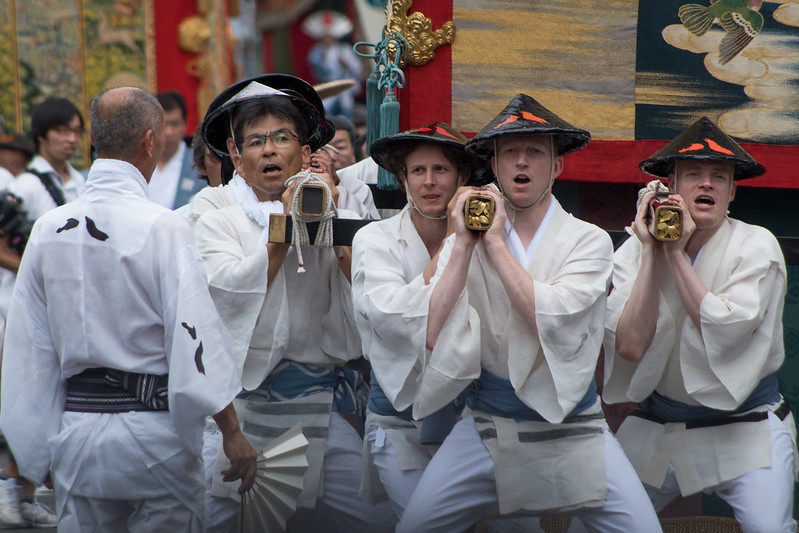Gion Matsuri
Kyoto’s Summer Symphony of Tradition, Craft, and Community Spirit
2026/06/30 - 2026/07/30
Every July, Kyoto’s historic streets come alive with the vibrant energy of Gion Matsuri. For a full month, towering floats, enchanting festival music, and the excitement of summer blend centuries-old tradition with the lively pulse of modern Kyoto. Whether you’re a culture lover, a photographer, or a family seeking the true essence of Japanese summer, Gion Matsuri is a feast for the senses and a celebration that brings everyone together.
The sound of wooden geta sandals on stone, the aroma of incense and yakisoba, and the sight of yukata-clad crowds gathered under lantern-lit floats create a magical atmosphere. Locals and visitors alike share in the joy and spectacle that has defined Kyoto’s summer for over a thousand years.
Main Attractions
The “Moving Art Museum”: Yamaboko Parade & Thrilling Tsuji-mawashi
The main highlight of Gion Matsuri is the Yamaboko Junko, held on July 17 and 24. Magnificent floats, some towering 25 meters tall and weighing up to 12 tons, are pulled through the city by teams of men in happi coats. Each float is a work of art, adorned with Nishijin brocade, gold leaf, antique tapestries, carvings, and lanterns. The creak of wooden wheels, rhythmic chants, and showers of confetti create an atmosphere that is both grand and warmly communal.
During the Yoiyama evenings (July 14–16 and 21–23), floats line the streets, glowing under lantern light in a dreamlike scene. Enjoy street food and lucky charms as you stroll through the summer night. Throughout July, sacred rituals, music, and smaller parades continue, drawing over a million visitors to Kyoto each year.
Yukata, Lanterns, and the Colors of Kyoto’s Summer
Gion Matsuri is a visual delight. Participants wear yukata, happi coats, and straw hats; children carry lanterns; and each neighborhood competes in decorating their floats with gold leaf, Nishijin textiles, and centuries-old fabrics. Streets are lined with banners and lanterns, and the sounds of flutes, drums, and bells fill the air. The scents of incense, grilled squid, and shaved ice evoke the essence of a Kyoto summer.
Street Food and Machiya Feasts: The Taste of Gion’s Summer
Festival stalls line the streets with Kyoto specialties like yatsuhashi, yakitori, takoyaki, and ramune soda. Families gather in machiya townhouses for somen noodles, seasonal vegetables, chilled matcha, and sake. Pickled cucumbers and matcha sweets enjoyed under the lanterns are a summer tradition in Kyoto.
Cultural and Historical Background
Gion Matsuri traces its origins to 869 CE, when a devastating plague struck Kyoto. Sixty-six halberds were erected at Shinsen-en, and the mikoshi (portable shrine) of Yasaka Shrine (then Gion-sha) was paraded to pray for relief. This ritual, born from a desperate wish to protect the city, gradually evolved as Kyoto’s townspeople (merchants and artisans) took the lead, shaping the prototype for today’s Yamaboko parade.
Though the festival was interrupted by events like the Onin War (1467–77), great fires, wars, and epidemics, it was revived each time by the determination of the townspeople. From the 16th century onward, each neighborhood owned and managed its own float, competing in lavish decoration with Nishijin brocade, imported tapestries from Persia and Belgium, intricate carvings, and gold leaf, earning the parade its nickname “moving art museum.”
The Yamaboko Junko originally served as a “purification” procession before the main mikoshi parade (Shinko-sai), and is divided into the Saki Matsuri (pre-festival) and Ato Matsuri (post-festival). After various changes, the two-part parade was restored in 2014 for the first time in about 50 years, returning closer to its original form.
Gion Matsuri is a symbol of pride, craftsmanship, and unity for Kyoto’s people-much more than just a festival. Its history of overcoming plagues, disasters, and wars is still alive in the bonds and culture of the community. In 2016, the festival’s floats were inscribed on UNESCO’s Intangible Cultural Heritage list, recognizing their global cultural value.
Participant Voices
I was born and raised in Kyoto, and Gion Matsuri is the highlight of every year. Pulling the float with my neighbors, listening to the festival music, and eating watermelon after the parade… it’s a tradition that truly connects our community.
Festival Dates
Gion Matsuri is held every July throughout Kyoto. The biggest highlights are the Yamaboko Junko parades and Yoiyama evenings on July 17 and 24. Be sure to visit Kyoto during this time for the full experience.
The event schedule is subject to change. Please check the official website for the most up-to-date information.
Media

photo by Max Fan

photo by Kanji Yamada

photo by piyopiyo4649

photo by strawberryfields31415

photo by piyopiyo4649
Information
| Name | Gion Matsuri |
| Country | Japan |
| Area | Kyoto, Yasaka Shrine |
| Date | 2026/06/30 - 2026/07/30 |
| Link |
Upcoming Festivals
Whirling Dervishes Festival Turkey
A Mesmerizing Dance of Divine Love
2025/12/06Mevlana Celaleddin Rumi Commemoration Ceremony ( Şeb-i Arus ) Turkey
A Whirling Journey to Divine Love
2025/12/10Dia de la Virgen de Guadalupe Mexico
A Festival Weaving Faith, Fervor, and Mexican Identity
2025/12/11L'Escalade Switzerland
Geneva’s Grand Winter Festival of Courage, Chocolate, and Community
2025/12/12Umkhosi Wokweshwama South Africa
The Zulu First Fruits Festival—A Sacred Celebration of Land, Ancestors, and Renewal
2025/12/12Lucia Festival (St. Lucia's Day) Sweden
A Festival of Light Illuminating the Nordic Darkness
2025/12/15Las Posadas Mexico
The Luminous Quest for Sacred Shelter
2025/12/22Noche de Rabanos (Night of the Radishes) Mexico
A celebration blending art, farming heritage, and cultural traditions
2025/12/23Chant of the Sybil on Majorca Spain
A Medieval Prophecy Echoes Through Majorcan Christmas
2025/12/23‘Hatajo de Negritos’ and the ‘Hatajo de Pallitas’ Peru
A Christmas Festival of Rhythm, Faith, and Afro-Andean Heritage in Peru’s Ica Region